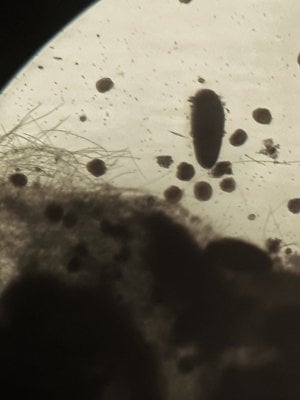What level P & N are you trying to achieve or did you get to when you started seeing the dinos recede?
10 ppm no3 and 0.1 po4. I had a hard time getting the phosphate to rise but 4 days after i got it there the dino pretty much were gone
Follow along with the video below to see how to install our site as a web app on your home screen.
Note: This feature may not be available in some browsers.
What level P & N are you trying to achieve or did you get to when you started seeing the dinos recede?
- In at least some systems, it was Iron.
Metro may be a starting point to put the Dino on the run until you get the po4 and no3 up.Metro man try it, but people need to do a couple rounds of it cause it cysts.

Given the lack of ability to test for it, was this deduced by adding/removing GFO or something, or how did you know?
I truly haven't seen anything about Fe and dino's in the literature (which is why I think I may have skipped over this point when you brought it up in the past) so this angle is legitimately interesting....not playing Red Team here.
Metro may be a starting point to put the Dino on the run until you get the po4 and no3 up.
http://onlinelibrary.wiley.com/doi/10.4319/lo.1978.23.3.0534/full
Iron in Maine coastal waters; seasonal variation and its apparent correlation with a dinoflagellate bloom
During 1975, 12 km south of Boothbay Harbor, soluble iron concentrations in the first 20 m of water were three times greater in October and November than in August and September, while particulate iron concentrations only increased transiently before the fall bloom. Nutrient enrichment experiments and chlorophyll a : cytochrome f1 ratios indicated that low iron concentrations limited phytoplankton populations. In August 1976, 1–4 km from Monhegan Island, increased iron concentrations from land runoff preceded a dinoflagellate bloom.
Metro may be a starting point to put the Dino on the run until you get the po4 and no3 up.
Implied with that strategy is removal of all artificial or extra means of nutrient reduction from the system: carbon dosing (vodka, pellets, etc), GFO, bacterial additives, et al. Even taking macro algae and other sources of N and P competition offline in some cases can help.
Some people got a dino bloom that had been stalled - to resurge by simply adding an Fe supplement.Given the lack of ability to test for it, was this deduced by adding/removing GFO or something, or how did you know?
I truly haven't seen anything about Fe and dino's in the literature (which is why I think I may have skipped over this point when you brought it up in the past) so this angle is legitimately interesting....not playing Red Team here.

Some people got a dino bloom that had been stalled - to resurge by simply adding an Fe supplement.
It worked in my tank (briefly), dino population stalled at the same time macroalgae began to show signs consistent with low Fe, then later I pulled out stalled ostreopsis dino population out of tank into beakers and tested Control, adding Fe, and adding VitB12.
The +Fe populations increased above the B12/control ones, - oddly the VitB12 test increased bubble production - higher photosynthesis rates? - though that might have been from some of the fillers in the B12 pill.

@m0jjen any chance we can get a video? movement would really help. Or adjust lighting to show some internal structure of the dino cells? From outline, it looks deeply grooved, could be a weird one.
@Randy Holmes-Farley - yep. B12 requirement shows up in a bunch of Algae - your citation was what I had run across before trying the beaker tests. Was chasing a theory that there was some shenanigans going on with maybe Cobalt coming in as the trace element, cyanobacteria turning it into cyanocobalamin (Vit B12) and dinos using the B12 as it is a requirement of theirs. (So Fe and Co/B12 both looked like good candidates.)
Maybe it happens in some cases. Kinda difficult to demonstrate though. Hence the side by side beaker tests of Control, Added Fe, Added B12. Seems Fe did best (grew most ostreopsis Dinos), but B12 produced more bubbles, so B12 seemed to help some aspect of what was going on. Both those outperformed control beakers.
Anyway, ID-ing what exact trace element is limiting in a certain case was a hard problem, and not much payoff, since in different systems there seem to be different limiting factors.
...and the way to induce the limitation would be pretty similar regardless.
It's what this thread is advocating.
(unless, Randy you've got some chemistry kung-fu secret you could share to quickly drain Iron, Co or other trace metals down to zero out of a reef system, that'd be fun)
Vitamin B-12 has cobalt in it. Could be the cobalt is also a limiting factor in some situations, but more likely, you had a species that required extrnal vitamin B-12, which is established in the scientific literature:
kung-fu secret you could share to quickly drain Iron, Co or other trace metals down to zero out of a reef system


Someone dose yogurt. Jk

